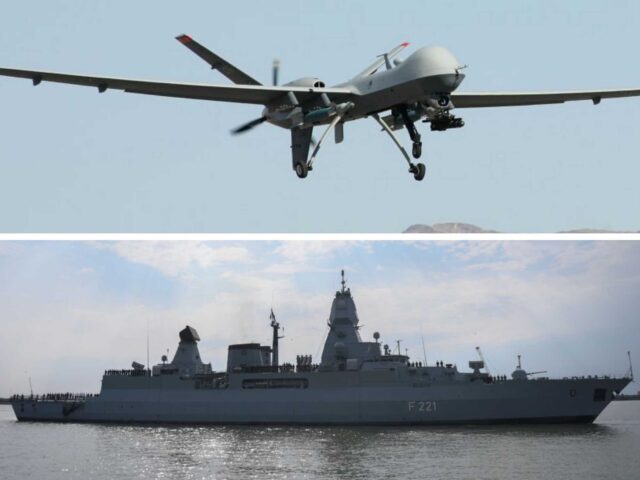German frigate inadvertently attempted to shoot down a U.S. MQ-9 Reaper drone on Tuesday night, but the American aircraft was saved by the German’s missiles malfunctioning and falling harmlessly into the sea.
Serious issues are implied for NATO military cooperation and capability after it was revealed one of Germany’s top warships wasn’t informed a U.S. drone was operating in its area, attempted to shoot it down, and failed.
The Frigate Hessen was deployed to the Red Sea earlier this month as part of the European Union’s mission to defend merchant shipping from Houthi attacks — an operation distinct from the U.S.-UK-led coalition to do the same thing, but which Europe declined to join — and enjoyed its first successful engagement on Tuesday, splashing two Houthi drones on Tuesday. But shortly afterwards another unidentified drone flying in the Hessen’s patrol area was detected, and fired upon.
German tabloid newspaper Bild reports the ship had been in contact with allied nations operating in the region and none reported they had drones operating in the area as part of the process of deciding whether to fire at the unidentified aircraft. Later, it transpired the United States was secretly operating a ‘dark’ drone with its transponder turned off above the Hessen, but hadn’t told anyone.

08 February 2024, Lower Saxony, Wilhelmshaven: The Bundeswehr intends to take part in the operation in the Red Sea with the frigate “Hessen”. Photo: Sina Schuldt/dpa (Photo by Sina Schuldt/picture alliance via Getty Images)
Worry Houthi Attacks on Global Shipping Will Disrupt Progress on Cutting Inflation https://t.co/ovdHYsSCS3
— Breitbart London (@BreitbartLondon) February 2, 2024
A defence spokesman said of the attempt to take down the crypto-American drone, which was subsequently revealed to be a MQ-9 Reaper, reports Die Welt: “The case was resolved in that it was not a hostile drone, which only became clear afterwards.”
The Hessen launched two air defence missiles, but embarrassingly for Germany, both malfunctioned and fell into the sea. The Raytheon-made SM-2 missiles are the same kind carried aboard U.S. Arleigh Burke-class destroyers, and are also used by a host of other NATO navies.
Bild emphasises the failure, even if it was a fortuitous one against an ally in this case, underlines the parlous state of the underfunded German military. Indeed, the embarrassment has a third dimension, as it was revealed this week that one of the kinds of ammunition carried by German Frigate Hessen is no longer made and cannot be replaced as it is used, meaning when the stock is exhausted, so is the ship.
News magazine Focus reports German parliamentarians who voted on whether to dispatch their nation’s warship to the Red Sea weren’t even aware of this limitation before it was deployed. The report did not specify which weapon system was particularly impacted by the degraded industrial capacity, but this is not a problem unique to Germany.
The United Kingdom has also expressed the limitations of the post-Cold War ‘feast to famine’ style of defence procurement, where there is no system of continuous production for advanced munitions. This has been particularly felt because of the Ukraine conflict, in which the advanced and almost brand-new NLAW anti-tank missiles were found to be very effective and in great demand, but yet a weapon that was barely out of testing already already had a broken supply chain.
Key components of the weapon system had been made by companies that had already ceased to exist, it was revealed, with expertise and tooling lost. Overcoming these issues, senior British figures have said, presents a major challenge to Western nations.
Crew Abandons ‘Sinking’ Ship Struck by Houthi Missilehttps://t.co/Pp6IWX7GgB
— Breitbart London (@BreitbartLondon) February 19, 2024

COMMENTS
Please let us know if you're having issues with commenting.